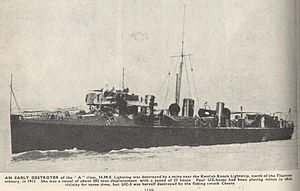HMS Lightning (1895)
 HMS Lightning
| |
| History | |
|---|---|
| Name | HMS Lightning |
| Ordered | 7 November 1893 |
| Builder | Palmers |
| Laid down | 28 March 1894 |
| Launched | 10 April 1895 |
| Completed | January 1896 |
| Fate | Sunk off Lightship 30 June 1915 after striking mine |
| General characteristics | |
| Class and type | Janus-class destroyer |
| Displacement | 320 long tons (330 t) full load |
| Length | 204 ft 6 in (62.33 m) oa |
| Beam | 19 ft 9 in (6.02 m) |
| Draught | 8 ft 0 in (2.44 m) |
| Installed power | 3,900 ihp (2,900 kW) |
| Propulsion |
|
| Speed | 27 kn (50 km/h; 31 mph) |
| Armament |
|
HMS Lightning was a Janus-class destroyer of the British Royal Navy, later designated an A-class destroyer, built by Palmers and launched in 1895.
Design and construction

Three
Lightning, together with the other two Palmer-built destroyers, was laid down on 28 March 1894, and was launched on 10 April 1895.
Service
The Palmer-built ships were considered the best of the 27-knotters, and at one stage, both Lightning and Janus were selected for service in distant overseas stations,
Lightning took part in the 1896 British Naval Manoeuvres, attached to the
In 1910, Lightning was part of the Sixth Destroyer Flotilla, based at The Nore, still being based at the Nore in 1912.[18] On 25 April 1912 Lightning collided with the torpedo boat TB 17 in Stangate Creek. Both ships were damaged, and required docking for repair, with Lightning's bow damaged and TB 17 holed below the waterline.[22]
On 30 August 1912 the Admiralty directed all destroyers were to be grouped into classes designated by letters based on contract speed and appearance. After 30 September 1913, as a 27-knotter, Lightning was assigned to the A class.[23][24][25]
Lightning, assigned the
References
Notes
- ^ "Cwt" is the abbreviation for hundredweight, 12cwt referring to the weight of the gun.
Citations
- ^ a b c d Lyon 2001, p. 77.
- ^ Lyon 2001, pp. 19–20.
- ^ Chesneau and Kolesnik 1979, p. 87.
- ^ Manning 1961, p. 39.
- ^ Friedman 2009, p. 54.
- ^ Friedman 2009, p. 291.
- ^ Lyon 2001, pp. 98–99.
- ^ Lyon 2003, p. 100.
- ^ a b Friedman 2009, p. 302.
- ^ Brassey 1897, p. 321.
- ^ "Splendid Results by a Jarrow-Built Torpedo-Boat Destroyer". The Marine Engineer. Vol. XVII. December 1895. p. 358.
- ^ "The "Sokol"". The Marine Engineer. Vol. XVII. December 1895. p. 358.
- ^ "H.M.S. Lightning In Collision". The Times. No. 34731. 11 November 1895. p. 11.
- ^ "The "Lightning" Court Martial". The Marine Engineer. Vol. XVII. January 1895. p. 394.
- ^ "The Engineers in the "Lightning"". The Marine Engineer. Vol. XVII. December 1895. p. 358.
- ^ Lyon 2001, p. 116.
- ^ Brassey 1897, pp. 141–143, 149.
- ^ a b "NMM, vessel ID 370126" (PDF). Warship Histories, vol ii. National Maritime Museum. Archived from the original (PDF) on 1 November 2014. Retrieved 31 October 2014.
- ^ "Naval & Military intelligence". The Times. No. 36767. London. 14 May 1902. p. 12.
- ^ "Naval & Military intelligence". The Times. No. 36839. London. 6 August 1902. p. 8.
- ^ a b "Naval Matters—Past and Prospective: Portsmouth Dockyard". The Marine Engineer and Naval Architect. Vol. 30. 1 December 1907. p. 171.
- ^ "Naval Matters—Past and Prospective: Sheerness Dockyard". The Marine Engineer and Naval Architect. Vol. XXXIV. June 1912. p. 436.
- ^ Gardiner and Gray 1985, p. 18.
- ^ Manning 1961, pp. 17–18.
- ^ a b Dittmar and Colledge 1972, p. 56.
- ^ "Supplement to the Monthly Navy List Showing Organisation of the Fleet, Flag Officers' Commands &c: Local Defence Flotillas". The Navy List: 13. January 1915. Retrieved 31 October 2014.
- ^ Smith, Gordon. "April - June 1915". World War 1 at Sea - Royal Navy Vessels Lost and Damaged. Naval-history.net. Retrieved 31 October 2014.
- ^ Kindell, Don. "1st - 31st June 1915 in date, ship/unit & name order". World War 1 - Casualty Lists of the Royal Navy and Dominion Navies. Naval-history.net. Retrieved 31 October 2014.
- ^ Helgason, Guðmundur. "Ships hit during WW1: HMS Lightning". uboat.net. Retrieved 31 October 2014.
Bibliography
- Brassey, T.A. (1897). The Naval Annual 1897. Portsmouth, UK: J. Griffin and Co.
- Chesneau, Roger & Kolesnik, Eugene M., eds. (1979). Conway's All The World's Fighting Ships 1860–1905. London: Conway Maritime Press. ISBN 0-85177-133-5.
- ISBN 978-1-86176-281-8.
- Dittmar, F.J.; Colledge, J.J. (1972). British Warships 1914–1919. Shepperton, UK: Ian Allan. ISBN 0-7110-0380-7.
- Lyon, David (2001) [1996]. The First Destroyers. London: Caxton Editions. ISBN 1-84067-364-8.
- Manning, T. D. (1961). The British Destroyer. Putnam & Co. OCLC 6470051.
- March, Edgar J. (1966). British Destroyers: A History of Development, 1892–1953; Drawn by Admiralty Permission From Official Records & Returns, Ships' Covers & Building Plans. London: Seeley Service. OCLC 164893555.
